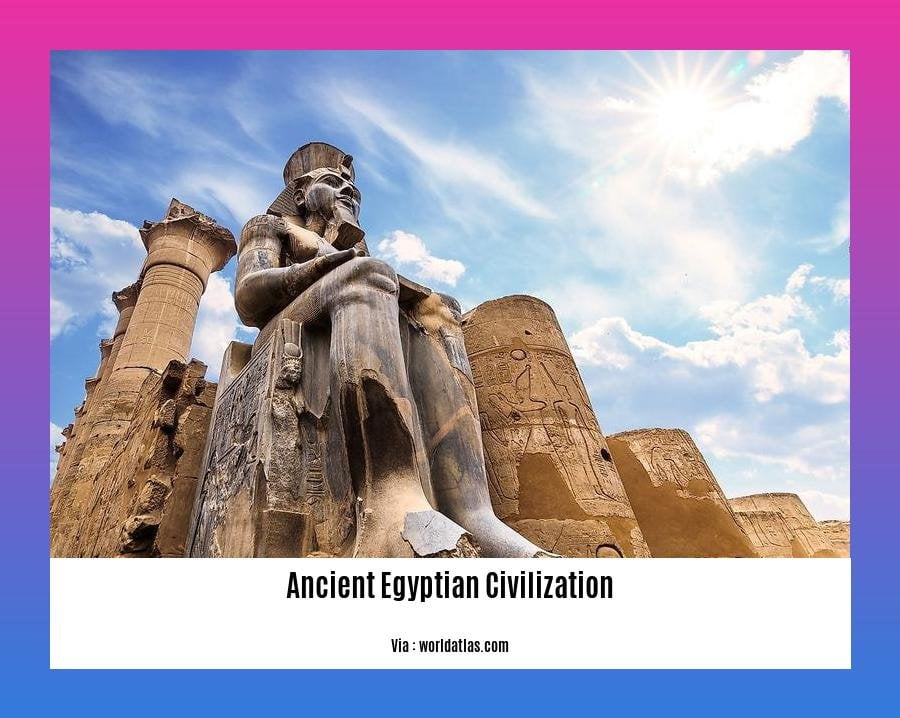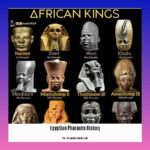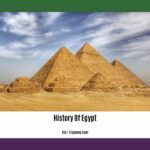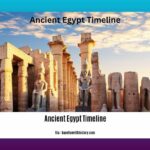Embark on an extraordinary journey to decipher the enigmatic legacy of Ancient Egyptian civilization. Join us as we delve into the captivating realm of pyramids, pharaohs, and hieroglyphs, unlocking the secrets of a culture that has captivated imaginations for centuries. Our expert guide, a renowned Egyptologist, will illuminate the grandeur, unravel the mysteries, and bring the captivating legacy of this ancient civilization to life.
Key Takeaways:
- Ancient Egypt thrived along the Nile River, using its annual flooding for fertile soil.
- The civilization lasted approximately 3,000 years, from 3100 B.C. to its conquest by Alexander the Great.
- Egypt’s economy and culture revolved around the Nile River.
- The social structure was complex, with a pharaoh as the absolute ruler.
- Ancient Egyptians made significant advancements in science and medicine.
- They had a complex religious system with multiple deities and a belief in an afterlife.
- Egyptians developed a writing system using hieroglyphics.
- The civilization is renowned for its monumental structures, including the pyramids and temples.
Ancient Egyptian Civilization
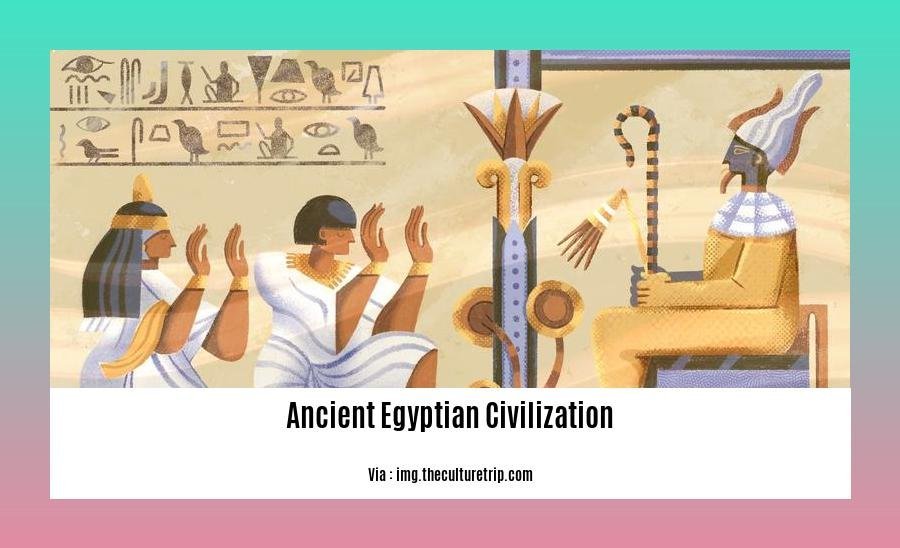
What is it?
Ancient Egyptian civilization, a society focused along the Nile river valley some 3,000 years ago, was an amazing feat.
A Gift From the Nile:
The river gave the Egyptian people fertile soil for farming, transportation, and water.
How it was Ruled:
The pharaoh was the supreme ruler of a complex social structure.
Achievements Aplenty:
Ancient Egyptian civilization is famous for its developments in math, astronomy, architecture, and medicine.
Belief in Gods and Afterlife:
Egyptians had numerous gods and thought in life after death.
How They Communicated:
They had a unique system of writing called hieroglyphics.
Amazing Monuments:
Pyramids and temples are just some examples of their impressive architecture.
If you’re craving knowledge about the ancient civilization, dive into the History of Egypt and unveil its captivating past.
To gain insights into the lifeblood of ancient Egypt, explore The role of the Nile River and witness its profound impact on the civilization’s development.
For a glimpse into Egypt’s recent transformation, venture into Modern Egypt’s development and discover its remarkable journey towards progress.
Religion and Beliefs
In the ethereal tapestry of ancient Egypt, religion and beliefs were an integral thread, weaving through every aspect of society. From pharaohs to commoners, faith permeated life, shaping their actions, inspiring their art, and offering solace in the face of the unknown.
Key Takeaways:
- Ancient Egyptians were polytheistic, believing in a multitude of gods and goddesses who governed natural forces and human affairs.
- The pharaoh was considered divine, serving as a mediator between the gods and human civilization.
- Formal religious rituals centered around the pharaoh, who acted as an intermediary between the people and the divine realm.
- Beliefs included the importance of maintaining balance (Ma’at) and harnessing the power of magic (Heka).
- Ancient Egyptian religion played a significant role in shaping their art and architecture, particularly in the निर्माण of elaborate temples and the depiction of deities in hieroglyphs.
Sources:
- Ancient Egyptian Religion | World Civilization – Lumen Learning
- Religious Beliefs and Practices of the Ancient Egyptians
Art and Architecture
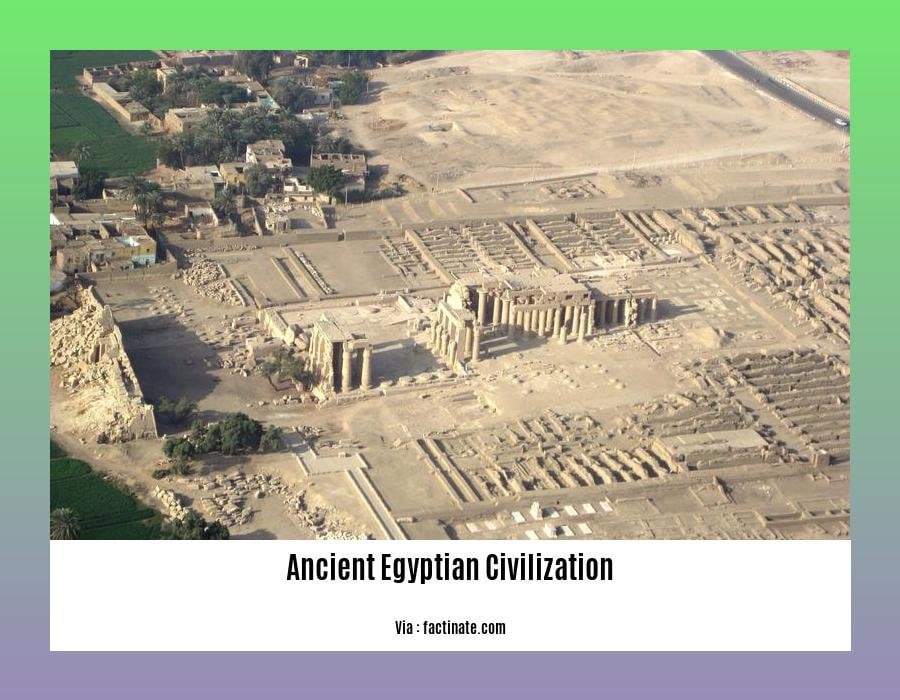
Peek into the artistic prowess and architectural ingenuity of the ancient Egyptians! Their Art and Architecture mirrored their deep connection to gods, nature, and everlasting life.
The pharaohs immortalized their power in grand architectural structures like the Great Pyramids of Giza, colossal temples, and opulent palaces. Skilled architects, using math and astronomy, designed these monuments to align precisely with the heavens, demonstrating their advanced knowledge.
Egyptian artists expressed their reverence for gods and the afterlife through breathtaking paintings and sculptures. Preserved in tombs, these works captured scenes from daily life, religious ceremonies, and mythological tales. Even the hieroglyphs they used had aesthetic value, forming intricate designs that adorned walls and artifacts.
Key Takeaways:
– Art and Architecture were deeply intertwined with religious beliefs and preservation of knowledge.
– Architecture showcases advanced knowledge in math, astronomy, and construction.
– Art, including paintings and sculptures, provides insights into daily life, mythology, and the afterlife.
Sources:
– Egyptian Art and Architecture
– Ancient Egyptian Architecture: Tombs, Temples, & Significance
Legacy and Influence: Unraveling the Tapestry of Ancient Egypt
The legacy and influence left behind by ancient Egypt are nothing short of profound, shaping myriad aspects of modern civilization. As their civilization flourished, they bestowed upon humanity invaluable contributions that continue to resonate today.
Unveiling the Heritage
The ancient Egyptians were brilliant innovators and masters of medicine, mathematics, written language, and art. Their advancements transformed the course of history:
- Medical science: The Egyptians developed effective surgical techniques, mastered anatomy, and created medical texts that influenced later civilizations.
- Mathematics: They devised a sophisticated numerical system and geometry, essential for architecture and astronomy.
- Written language: Their hieroglyphic script revolutionized communication, allowing them to record their history and ideas.
- Art and architecture: Their enduring monuments, such as the Great Pyramids and the Sphinx, showcase their unmatched skill and ingenuity.
Enduring Impressions
The legacy of ancient Egypt permeates contemporary life in countless ways:
- Art: Egyptian motifs and symbols grace everything from pottery to fashion.
- Architecture: Egyptian influences appear in column designs, pyramid-shaped buildings, and decorative elements.
- Education: Their educational system emphasized mathematics, writing, and practical skills, inspiring modern educational practices.
- Medicine: Ancient Egyptian medical knowledge laid the foundation for modern medical practices and treatments.
Unveiling the Past
Deciphering the legacy and influence of ancient Egypt remains a fascinating pursuit. By examining their artifacts, inscriptions, and monuments, we glimpse into a civilization that shaped the world as we know it. As we unravel its secrets, we continue to appreciate the profound impact they had on human history and culture.
Key Takeaways:
- Ancient Egypt made significant contributions to medicine, mathematics, written language, art, and architecture.
- Their inventions and discoveries laid the foundation for the modern world.
- Their cultural heritage continues to influence art, architecture, education, and medicine today.
- Studying ancient Egypt provides valuable insights into our past and the development of human civilization.
Citations:
FAQ
Q1: What were the key aspects of ancient Egyptian society and culture?
Q2: What advancements did the ancient Egyptians make in mathematics, astronomy, and medicine?
Q3: How did the ancient Egyptians’ religious beliefs shape their daily lives and artistic expressions?
Q4: What architectural marvels and masterpieces did the ancient Egyptians create, and what do they reveal about their culture?
Q5: How has the legacy of ancient Egyptian civilization influenced the modern world?
- Sept 31 Myth: Unveiling Calendar Secrets - March 18, 2025
- How Long & Till December 18, 2025: Accurate Countdown Guide - March 18, 2025
- Discover Japanese Artists: A Complete History - March 18, 2025
